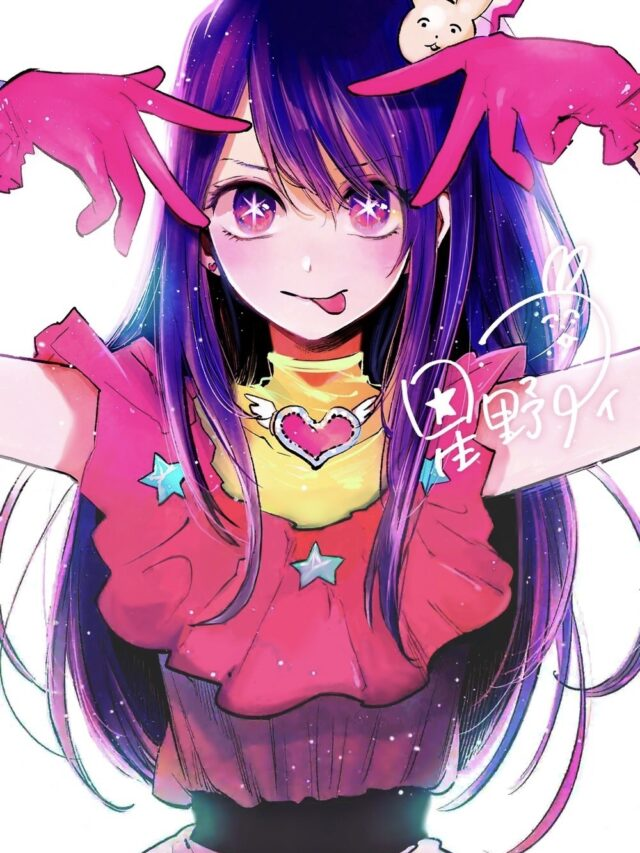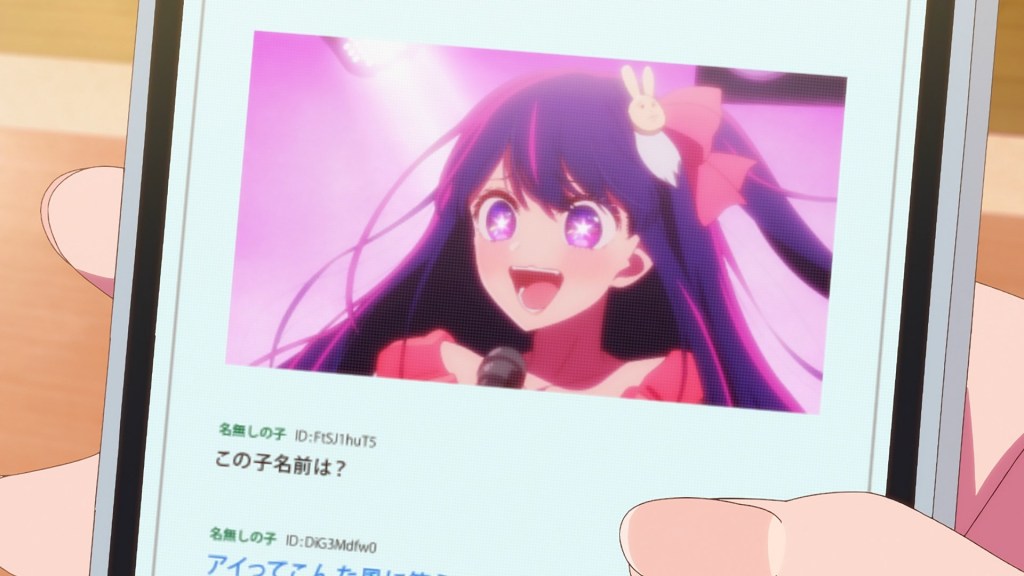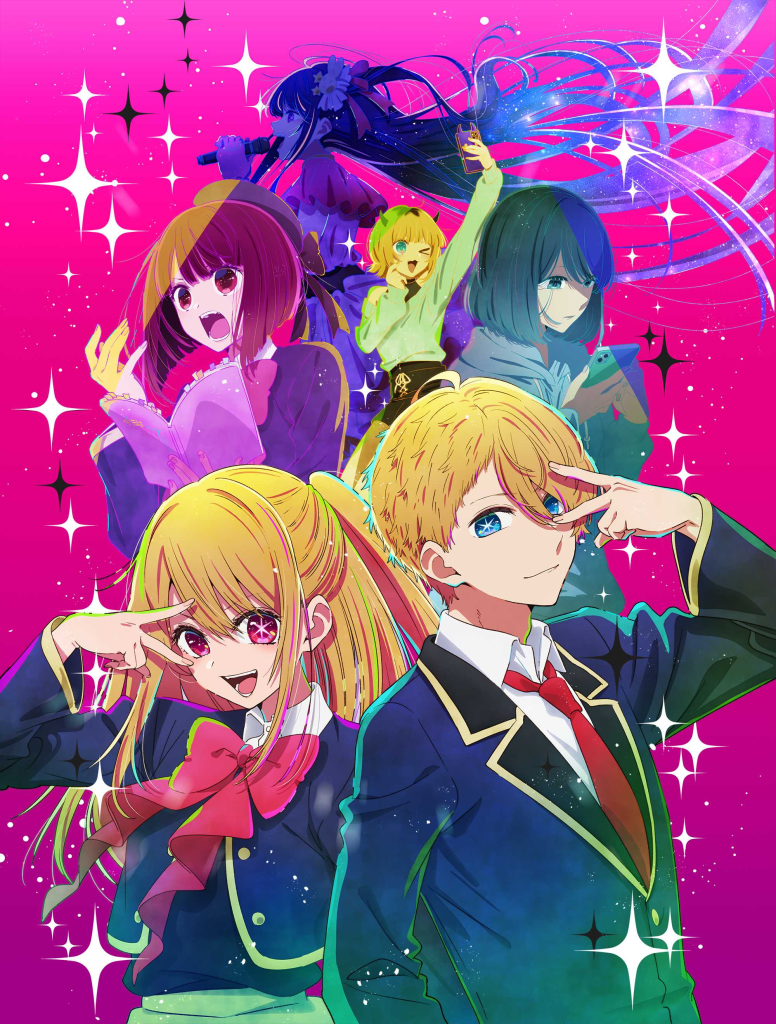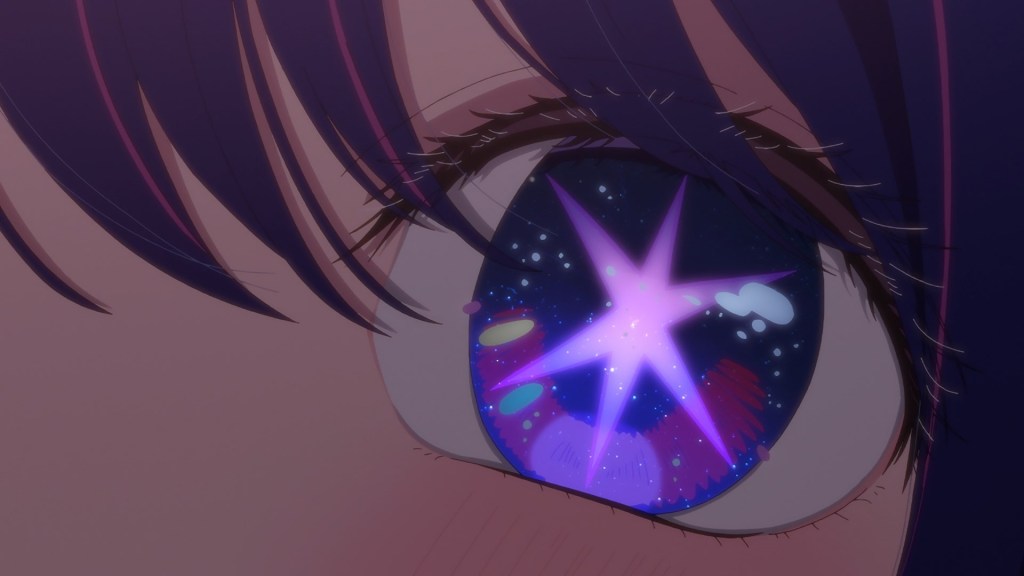Note: This post will not contain spoilers except for one section where I have marked it in bold. It is very difficult to talk about this series without spoiling the major events of episode 1, but I did my best to contain it to one section. However, I was not able to contain a lot of Ai puns, and for that I am truly sorry.

Oshi no Ko has become quite the big hit lately across the world, with its massive premiere, individual music videos for its OP and ED, fantastic art, and iconic leading girl in Ai. All over the internet are cover songs, dances, screencaps, reaction posts, and tons and tons of fanart for the series. In a season with heavy hitters Demon Slayer, Hell’s Paradise, Mashle, and Gundam on Crunchyroll, it’s crazy to me that Oshi no Ko on competitor HiDive would be such a sensation. The series was already very hyped up, as both the mangaka are successful in their own right and the absurd premise was the topic of much discussion, but now with this high-quality adaptation Oshi no Ko is a highspeed train going all the way. I’m a bit late to get on the train myself but, seeing the hype for the anime grow and then jumping into that 80-minute premiere myself has been a very interesting experience which I will go into later. Ever since that first episode, especially coming into it late, my head has been spinning with ideas about this series and how we’ve interacting with it. I’d like to share some of those thoughts with you, in particular the visuals of oshi no ko interest me. Besides the show simply looking amazing, one character has been dominating every visual, official and fan-creation, of this series. Ai has been everywhere, and given the content of the show, I find the effect it has had very fascinating. This whole thing has been a meditation on what affects the way we “see” anime in terms of its visual identity, but also on the fictional world of idols and vtubers, and how their lies are part of reality.
Spotl(Ai)ght on Kappe

Not very often you get a show that from it’s conception has both a wide sensational appeal to most corners of popular anime fandom and a close sakuga following, and Oshi no Ko is a show where you can point most of its technical appeal at one person, Kappe. I’ve heard about her work on the Rent-a-Girlfriend series, through the large number of her illustrations and designs that have been posted in discord and retweeted, keeping that anime as one of the visually stunning modern anime despite its…fairly problematic mc and plot.
Of course, Kappe is not the only person working on this show or is the singular entity making this show great, but her fingerprints are all over not just the credits but distinctly in the designs and animation. Many people on the team such as director Daisuke Hiramaki have worked with Kappe before and are able to effectively display her skills. Every design in this show is gorgeous, especially the main girls. Kappe really has a sharp sense of cute and beautiful in the way she draws hair and faces, especially in the line art and color shading. Somehow these incredible designs aren’t compromised in animation, with key cuts pulling off the detail and beauty of her work. Some of those key moments in each episode are quite breathtaking, stunning me with a detailed close up of galaxy eyes or a flutter of hair. Kappe’s high visual fidelity is of course enabled by effective storyboarding and episode direction, a combination that will take any anime to a household name.

For a specific example take a close look at the most distinct visual feature of Oshi no Ko’s main characters, the eyes. Eyes are extremely important as the visual theming in Oshi no Ko because of the “ai” pun and the star eyes of Ai, Aqua, and Ruby, but in the medium of anime where large, captivating eyes are already a norm, the eyes of Oshi no Ko’s anime still manage to stand out above the others. The main three don’t just have a star in their eyes, but practically hold an entire galaxy in their enormous pupils. Also the other characters like Kana and Akane too have large, captivating eyes with entire color gradients to keep that focus across the cast. I think it’s the way Kappe draws the eyelashes, in combination with the direction and storyboarding, that really allows you to get absorbed into a character’s eyes, and into their “lies” (following Ai’s main theme). This visual focus is what makes Akane’s moment at the end of episode 7 that much more impactful.
I mention Kappe specifically because we’re now at a time more than before that the general community are becoming more interested in the people behind the series they watch, and with Kappe’s work as the key highlight of the success of this adaptation, more people are going to know her name now. Each year there are more people who become interested in directors, key animators, and boarders, not just from the Sakuga community, but just in general. Something about great work on popular shows allows for more people to become familiar with these names. While writing this I clicked on a random Youtube short that was on my homepage about Oshi no Ko. It was just seemed like some generic anime channel where a guy just reacts to current popular anime like Demon Slayer but in this one he was talking about how good Oshi no Ko is and talking about Kappe, even showing some of her twitter art in the video. What I like about Kappe herself is that she seems to draw pretty girls with a lot of passion, with a lot of output outside of the animation itself, though art and excited tweets twitter, which has taken the attention of industry people as well.
(Ai)conography

Nearly every post that is about the series itself (rather than a single episode) uses one of two of Ai’s (ai)conic poses. One is the pose taken from the cover of volume 1 of Ai’s face with her tongue sticking out to the side, and the other is the anime visual of Ai on stage with her finger pointed up. These two exact poses from the images have become so pervasive that the anime visuals, news info, cosplays, and fanart all have replicated these two poses and the two together have become arguably the most common image associated with the series. Of course, there is a certain narrative (ai)rony associated with that, which I will get to in the next section, but here I would like to take a really close look at these two images and see how they have become integral to Oshi no Ko’s visual (ai)dentity, with Ai as the center of attention.
Starting with the pose on anime’s actual key visual: Ai on stage with her finger pointing up. There’s actually two visuals but they both contain the same pose so I will mention the two. On the surface this doesn’t seem like anything special, all idols have some kind of pointing pose, but these two work together effectively to sell the show and Ai herself. Its pretty clear that both of these visuals complement each other as part of Ai’s performance in the show and in the “Idol” music video as presentations of her idol profession. Anything that can be copied easily is a key characteristic of visual popularity in the anime space and the high degree of replicability of an idol pose, letting cosplayers and fanartists copy this pose with ease goes a long way in establishing a focal figure.


In addition, there are a couple of extra details in these visuals that allow it to pop out and fit into the context of Oshi no Ko. On the one from behind, since Ai is lit up from the front by a plethora of spotlights and thousands of fans waving glowsticks, we only see her darkened backside. Without seeing her face, this visual doesn’t seem to feature the star eyes that are so crucial to Ai’s design, but if you look closely at where she is pointing to the line from her finger leads right up to theの in Oshi no Ko, stylized with a star. A little bit of armchair-theorization could claim that this is a metaphor for Ai at the end of episode 1, but realistically its quite a stretch. Nonetheless, the lighting that highlights her idol silhouette and keeps her figure dark to us combined with the hidden presence of the star does make this image visually striking while still having some character relevance. On the flip side, we have the image of Ai from the front, in her more adapted anime design and color palette (though I noticed that her hair clip is slightly different in the final product). Ai’s figure pops out from the triptych style panels you see so commonly in Japanese promotional posters for film and series, the shadow around some of those lines really makes it look like Ai popping out of the picture. Looking closely at those background panels they are actually more images of Ai on a large stage screen, like that seen behand Aqua and Ruby in the OP and ED of the show. Ai’s energetic open-mouthed smile, winking face, and the effect lines emanating around her are just simply infectious as they bring our eyes right to her as the center of attention. This is the Ai that we know, though more accurately it would be the Ai that she wants us to know. The way Ai presents herself is also an important aspect to the other iconic image of Ai.

Despite being just the volume of volume 1 and not seen anywhere in the anime, Ai striking this pose has been one of the most recognizable images of her. Another great close-up of Ai’s eyes, emphasizing the galaxy that resides within. As eyes and all the associated puns are an important part of this series, a visual that highlights the metaphor made by the massive star pupils of Ai’s eyes is very important and is no surprise that it’s the cover of volume one. Ai in her idol dress stands front and center hitting some hand signs above her face. The pose itself is how you would an expect an idol to express herself, confident and expressive, which is who Ai is, but there are a few other details here for our eyes to latch on to.
Ai’s uniform consists of a layered dress and gloves in matching hot pink color. This is a color that pops out, especially with the plain white background and harmonizes with Ai’s long purple hair. Ai’s expression would be that of an idol’s expressive smile, but her tongue is sticking out, giving her a slightly silly demeanor, that perfectly encapsulates her personality as we see it in Oshi no Ko, a hardworking idol that also cracks jokes and makes fun faces. Finally, what makes the volume cover so fascinating is that while the two key names on the cover are of course those of Akasaka Aka and Yokoyari Mengo, there is a third name visible, Ai’s. Not only is Ai’s name on the cover but it’s her signature, placed right above the title, with the bunny as her mark. This cover is actually a signed idol card, the kind of merchandise that is sold at concerts, events, and hobby stores. Everyone who purchased this volume has actually bought idol goods, buying into her lies.
Fly(ai)ing out of the Screen
This section contains spoilers for episode 1
This now brings us to Ai herself, the central figure promoted by these images and who she is as a character, not just an image. Most people would expect to see the character who is not just featured on the majority of the visuals, but on all the videos, art, and cosplays as the most prominent character of the series, however that isn’t entirely true. After watching episode one or reading volume 1 this would seem to be a trick, a sort of bait-and-switch initial story arc adding both shock value and raising the stakes in Ai’s death initiating Aqua’s main quest. However, thinking over this initial episode in the past few weeks and while writing this piece, I actually find that Ai’s death and the reaction since still keeping her as the most prominent figure is perfectly fitting for Oshi no Ko.

I caught on to Oshi no Ko late. The anime had already been out for a number of weeks before I made the jump into episode 1, put off by its length but that interest has been there since the start. Before I finally caved, I saw Ai everywhere. She was on the manga cover, people were drawing fanart of her, of course the mvs and cover songs were all covered with her face. With only brief knowledge of Oshi no Ko thoroughly convinced that she was the main character, and seeing more and more of the twins just confused me with that little information I had. It was of course to my great surprise that Ai didn’t make it through episode 1 and that Aqua would be the main character (It should be both Aqua and Ruby but its really just the Aqua show). Ai’s dominating presence in the outward image of Oshi no Ko likely arose in the fandom as a way to avoid spoiling her death at the end of episode 1, as that is the key event that kicks off the series after that utterly ridiculous premise. Though, that avoidance of spoilers in the image of Ai fits exactly into her character and the main themes of the show, allowing for an additional layer of pervasiveness in Oshi no Ko which, I believe, confirms Ai as the main character.
Lies are, of course, the main theme of the series, and what greater lie is there than of the series itself. Every image, every cosplay, every fanart preserves the lies that Ai is the main character, the protagonist of Oshi no Ko. One of Ai’s most important lines is that “lies are an idol’s greatest strength”. Despite dying so soon, Ai has been lying and lied about constantly since the start, from the very first volume cover. Exercising just how powerful she actually is, her lies extend past the boundary of the series, into reality. Ai is the main character of Oshi no Ko as she is the most powerful character. Her lies have impacted the entire perception of the show to onlookers and the discussion of the show by fans, extending into the series where Ai is who Aqua and Ruby are following, and whose lies Akane has to adopt to keep on going. Ai’s presence is felt throughout the story and has a great effect on the main characters. Its no surprise that in the key visual of Aqua and Ruby, they are both copying Ai’s hand signs with each of theirs.

Final Thoughts: In a world of l(ai)es
So what does this all mean? Is this really just about one anime? Lately, I’ve been making me think about the relationships we have with media, and how something inside a series can affect the world outside out of it. What does it mean for a character who only appears briefly makes them to not just a major part of the series they are in, but take over the image of the series in real life? Does Ai capture the functions and meaning of idols? Is there some truth to her lies?

Idols are definitely a media product, operating more though their performative imagery rather than vocal capabilities. Idols often capture a different space than singers in the way we see and interact with them. They sell themselves to the audience (not in a sexual way, unless they do gravure) as a living image of youthful beauty, group setting, and suggested availability in the celebrity media. Of course, idolhood is a fabrication, a product developed by management companies, but most idol fans accept it and suspend their disbelief. By accepting the idol product without question, fans can genuinely express their excitement for listening to and seeing them perform. The idol industry is an industry of lies, the greater the lie the greater the idol, yet these lies aren’t deceptive, they are playful, enjoyable, and in some cases empowering lies.
What about vtubers then, who also sell themselves on performance as well, albeit virtually rather than physically (though nowadays both are more often interacted with through a screen)? Vtubers are “designed” as characters with a given setting (i.e Marine is a pirate, Ame is a detective etc.) based on anime tropes and iconography. Like with idols, we don’t actually believe in these settings and fantastical characteristics, yet we don’t deny them either. Accepting lies like Fubuki is a fox is how each vtuber fandom grows, and how fans express their appreciation though stream donations, creating fanart, buying goods and other forms. Its no wonder that vtubers are often compared to idols.

Vtubers are a fascinating concept to me in that I believe that they’ve created an entirely new media space in our digital age. The visual identity of vtubers is based on aesthetics and traits we are well familiar with although they aren’t anime or game characters themselves. They don’t just look and sound like the characters we see in anime and games, but they are fans of those things and interact with them like we do too. Unlike idols, vtubers are both characters of distant admiration but also of close identification. On the other hand, vtubers, like idols, are performed by people. It’s a “role” that a real person assumes, with their own emotions, livelihoods, and (should have their more) agency. That’s why when the lies are taken as a false truths as in the stories we hear about crazy fans, idols and vtubers are dehumanized.
Vtubers interact with anime and video game spaces in the way that they adopt the aesthetic and cultural codes within them, yet vtubers themselves don’t reside in those fictional spaces. At the same time, vtubers are the performances of real people in front of a camera but they are purely interactable within the virtual space of a stream or social media. That sense of being both virtual and real makes vtubers really fascinating in the context of idols, whose “virtual” space comes from the fictional space of lives (concerts) and the particular branding associated with the idol groups despite being within reality. Yet, even when the fictionality of these spaces isn’t what it used to be with the increased agency of individual idols through avenues like social media, the lies persist. Thinking about it in a different way, the “lies” of idols and vtubers is precisely what makes them “real”. This might be the 2.5 dimension.
The acceptance of lies, as we learn from Oshi no Ko, is the ultimate expression of fandom and the sign of a particular idol’s popularity and success. That is the meaning of “oshi”. We’ve all fallen in love with Ai as the main figure of the show despite the events of episode 1, and she remains to be herself a main theme of the series, and an influence on the fans as well, preserving her image as the visual identity of the show. In Ai’s own words “Lies are the ultimate form of love.”

Thank you for reading this far, this one was quite the doozy to write, though not as much as the 100gfs one. This whole thing started just from the excellent cliffhanger at the end of episode 7, which got me real good and started making me think much more about Ai and where she is outside of episode 1. Oshi no Ko really is shaping up to be one of the anime of the year, and while there are things I dislike about it, I’m really enjoying its drama and visuals. I hope you all have a wonderful day.



Leave a comment